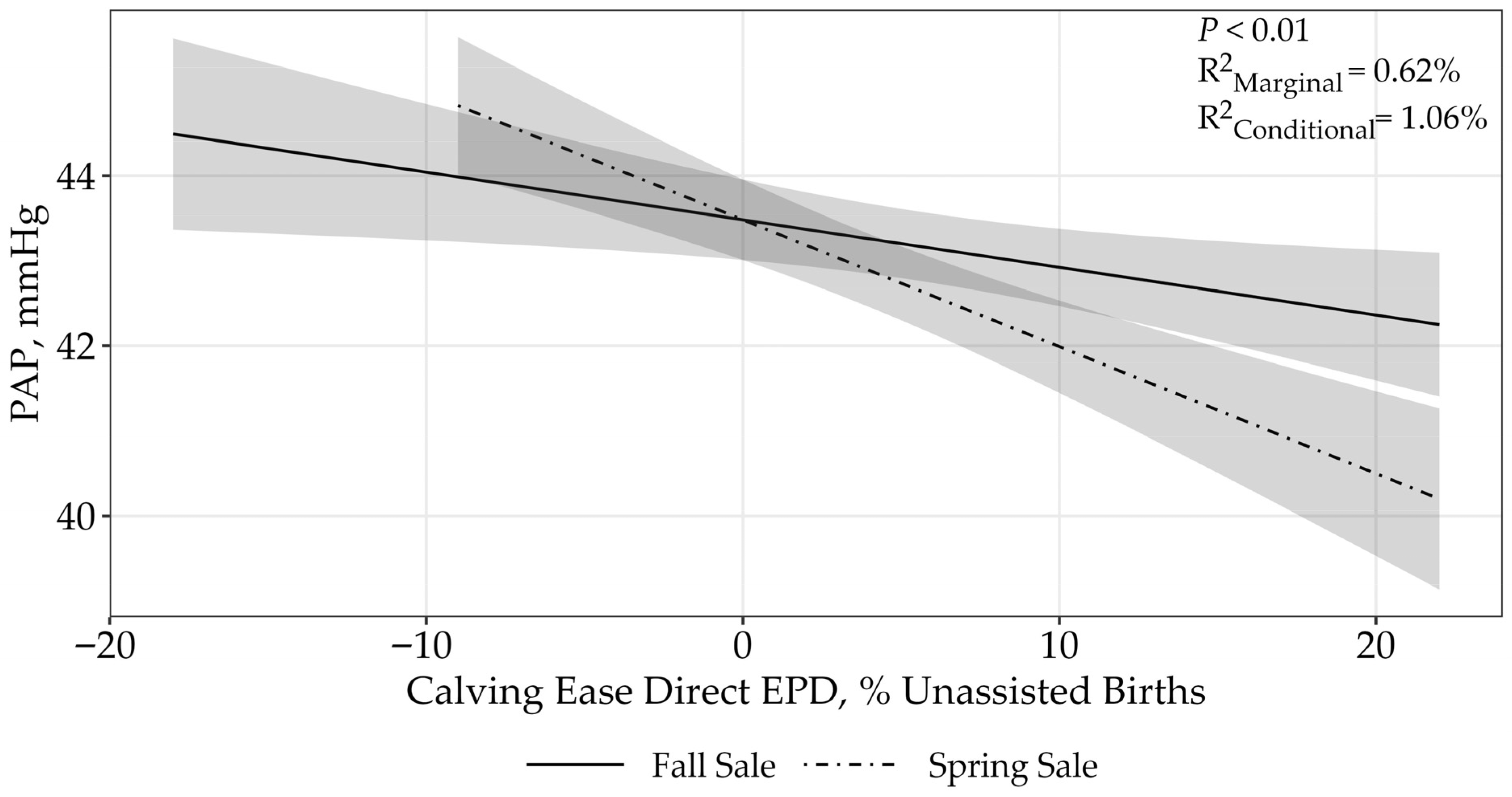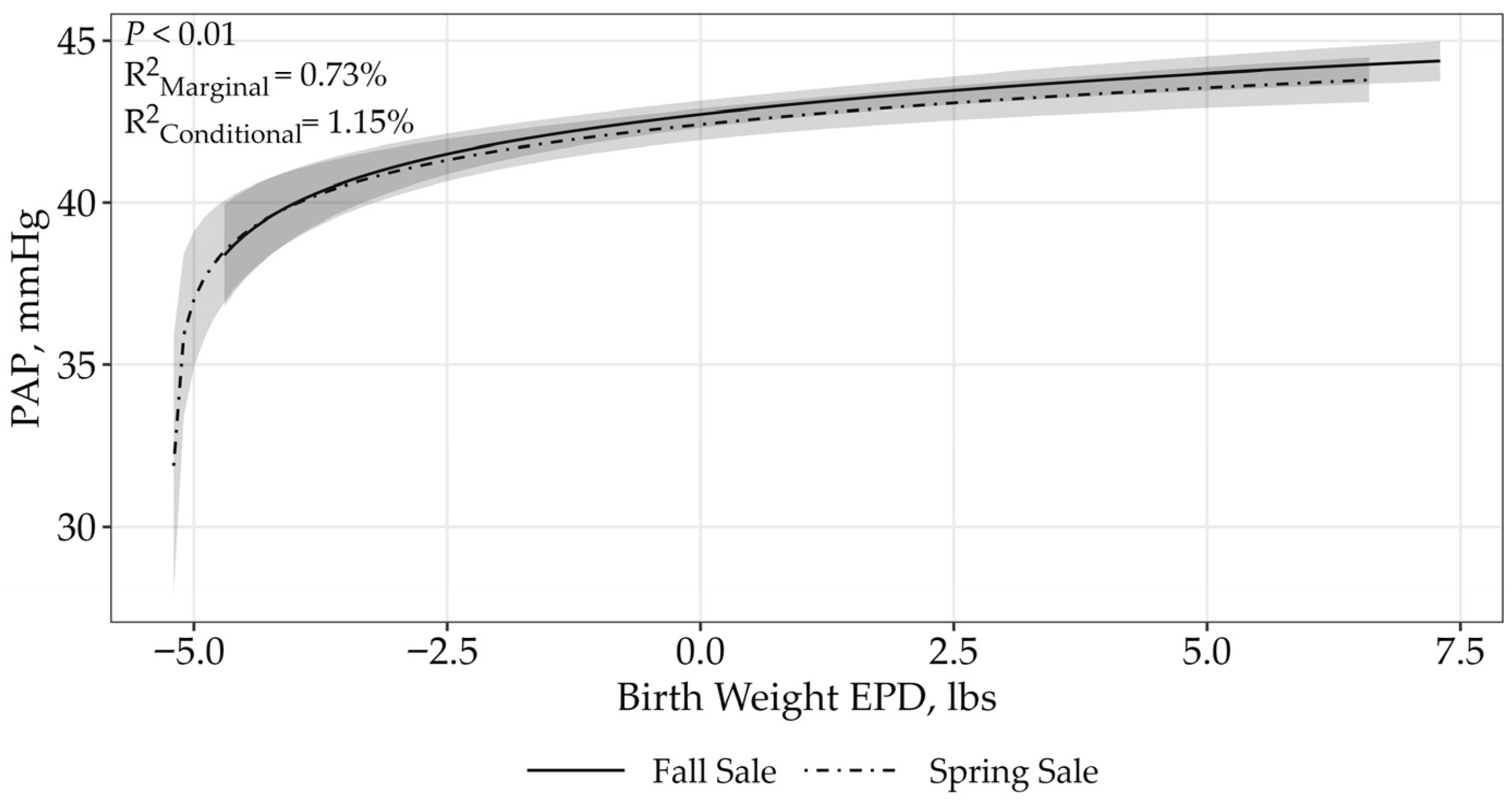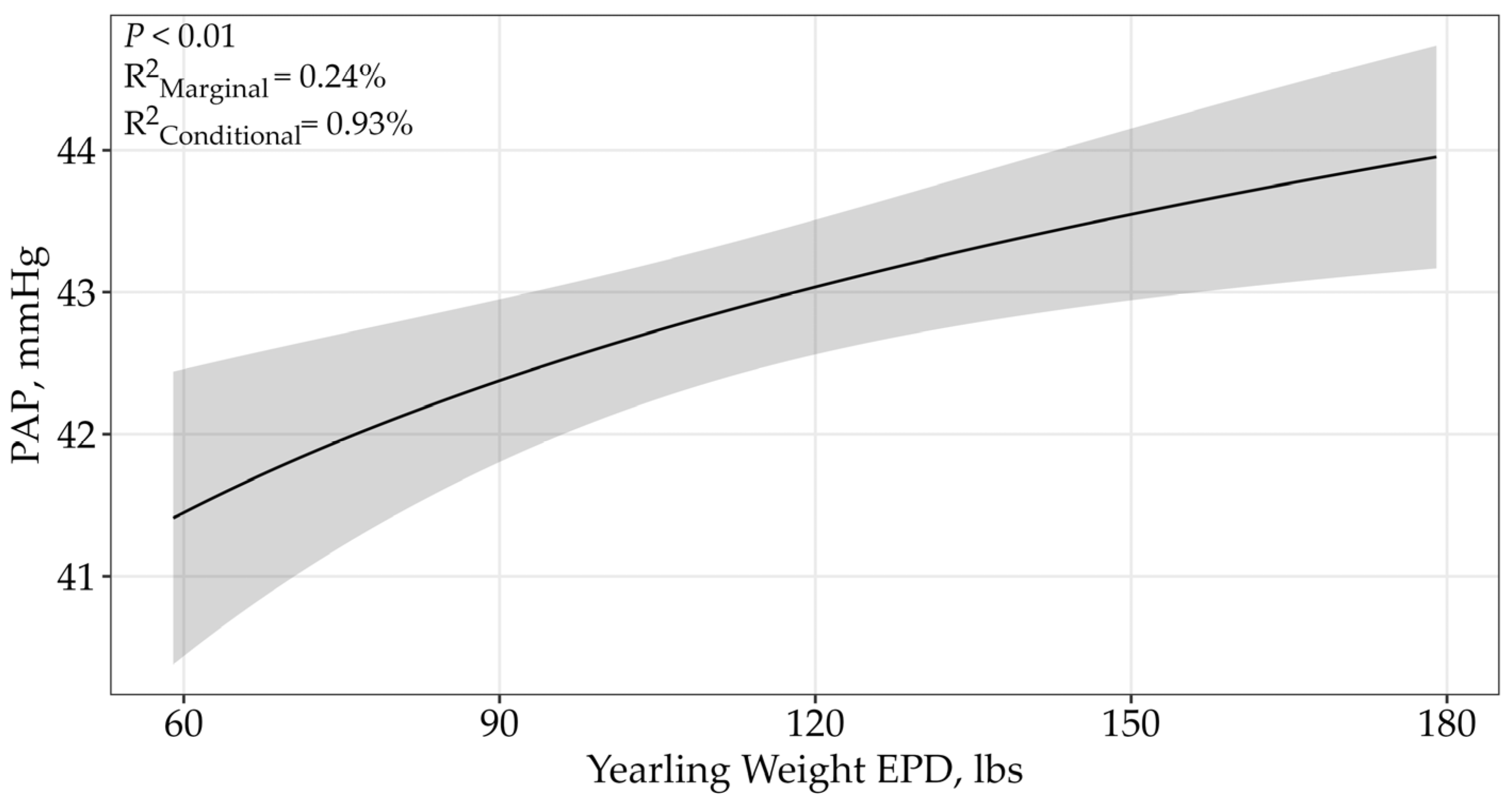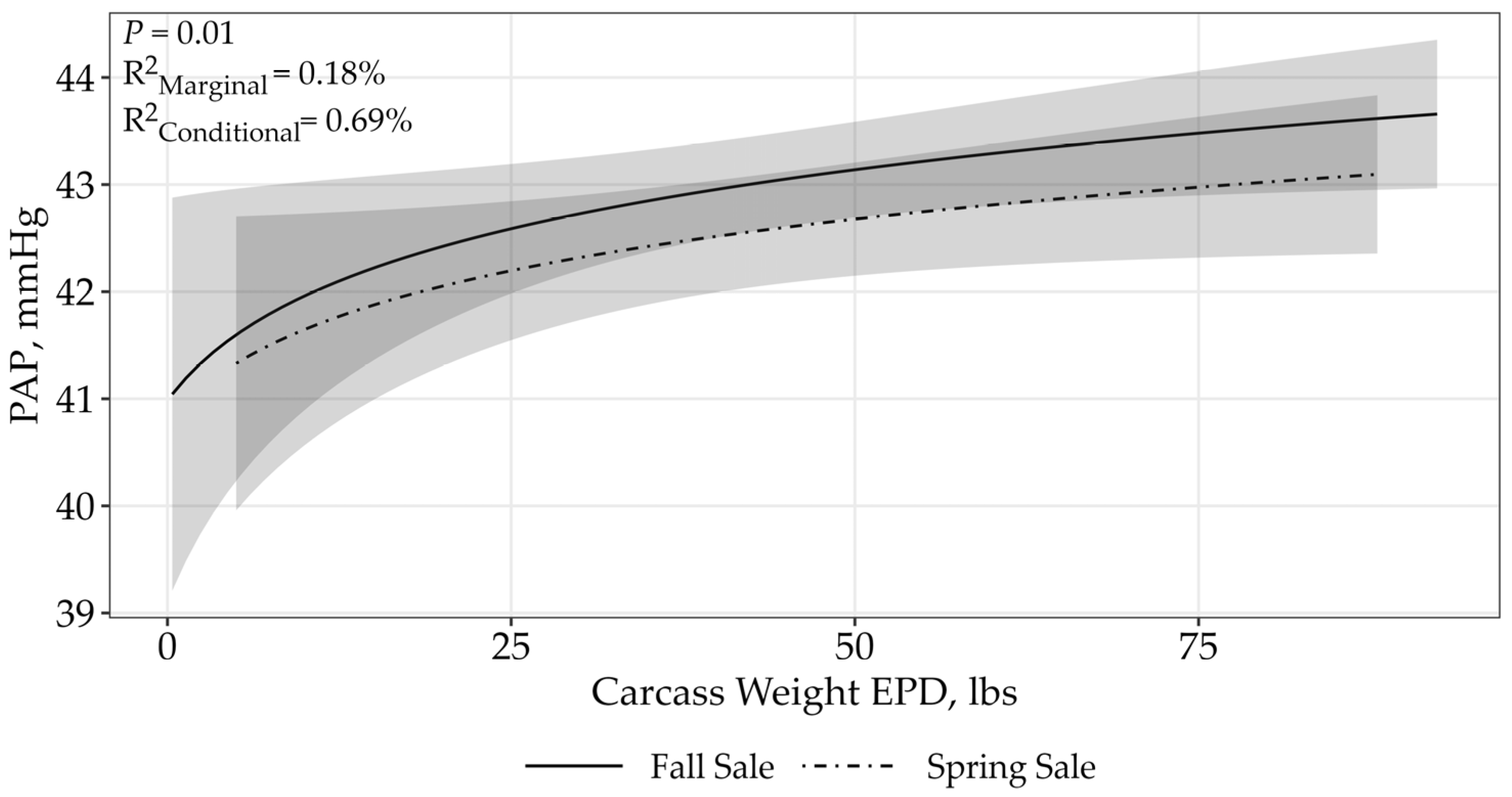Relationship of Yearling Angus Bull Pulmonary Arterial Pressure Scores with Production, Maternal, and Carcass Expected Progeny Differences
Simple Summary
Abstract
1. Introduction
2. Materials and Methods
2.1. Operation A
2.2. Operation B
2.3. Pulmonary Arterial Pressure Test
2.4. Data Collected
2.5. Statistical Analysis
3. Results
4. Discussion
5. Conclusions
Author Contributions
Funding
Institutional Review Board Statement
Informed Consent Statement
Data Availability Statement
Acknowledgments
Conflicts of Interest
Abbreviations
| HAD | High-Altitude Disease |
| HMD | High-Mountain Disease |
| RHF | Right-sided heart failure |
| EPD | Expected Progeny Difference |
| AAA | American Angus Association |
| AGI | Angus Genetics Inc. |
| CED | Calving Ease Direct |
| BW | Birth Weight |
| WW | Weaning Weight |
| YW | Yearling Weight |
| SC | Scrotal Circumference |
| Milk | Maternal Milk |
| CW | Carcass Weight |
| Marb | Marbling |
| RE | Ribeye Area |
| AICc | Akaike’s Information Criterion |
References
- Holt, T.N.; Callan, R.J. Pulmonary arterial pressure testing for high mountain disease in cattle. Vet. Clin. N. Am. Food Anim. Pract. 2007, 23, 575–596. [Google Scholar] [CrossRef] [PubMed]
- Markel, C.D. Characterizing Effects of Management Strategy and Degree of Pulmonary Hypertension on Live Growth Performance, Carcass Quality, and Respiratory Microbiome of Finishing Beef Cattle. Master’s Thesis, University of Wyoming, Laramie, WY, USA, 2023. [Google Scholar]
- Glover, G.H.; Newsom, I.E. Brisket Disease: Dropsy of High Altitudes; Agricultural Experimnet Station of the Agricultural College of Colorado: Fort Collins, CO, USA, 1914; Volume 204. [Google Scholar]
- Bovine High-Mountain Disease. Available online: https://www.merckvetmanual.com/circulatory-system/bovine-high-mountain-disease/bovine-high-mountain-disease (accessed on 31 July 2025).
- Williams, J.L.; Bertrand, J.K.; Misztal, I.; Łukaszewicz, M. Genotype by environment interaction for growth due to altitude in United States Angus cattle. Anim. Sci. J. 2012, 90, 2152–2158. [Google Scholar] [CrossRef] [PubMed]
- Alexander, A.; Jensen, R. Pulmonary Vascular Pathology of Bovine High Mountain Disease. Am. J. Vet. Res. 1963, 24, 1098–1111. [Google Scholar] [PubMed]
- Heath, D.; Castillo, Y.; Arias-Stella, J.; Harris, P. The small pulmonary arteries of the llama and other domestic animals native to high altitudes. Cardiovasc. Res. 1969, 3, 75–78. [Google Scholar] [CrossRef] [PubMed]
- Alexander, A. The bovine lung: Normal vascular histology and vascular lesions in high mountain disease. Respiration 1962, 19, 528–542. [Google Scholar] [CrossRef] [PubMed]
- Veit, H.; Farrell, R. The anatomy and physiology of the bovine respiratory system relating to pulmonary disease. Cornell Vet. 1978, 68, 555–581. [Google Scholar] [PubMed]
- EPD & $Value Definitions. Available online: https://www.angus.org/tools-resources/national-cattle-evaluation/epd-value-definitions (accessed on 18 July 2025).
- Pauling, R.C.; Speidel, S.E.; Thomas, M.G.; Holt, T.N.; Enns, R.M. Genetic parameters for pulmonary arterial pressure, yearling performance, and carcass ultrasound traits in Angus cattle. Anim. Sci. J. 2023, 101, skad228. [Google Scholar] [CrossRef] [PubMed]
- Stearns, K.; DelCurto-Wyffels, H.; Wyffels, S.; Van Emon, M.; DelCurto, T. The Use of Pulmonary Arterial Pressure (PAP) for Improved Beef Cattle Management. Animals 2024, 14, 2430. [Google Scholar] [CrossRef] [PubMed]
- Ryans, K.; Research PAP EPD Launched by Angus Genetics Inc. The Genetic Tool Will Allow Producers to More Easily Identify Cattle Less Susceptible to High Altitude Disease; Mefford, C., Ed.; American Angus Association: St. Joseph, MO, USA, 2019. [Google Scholar]
- Thomas, M.G.; Neary, J.M.; Krafsur, G.M.; Holt, T.N.; Enns, R.M.; Speidel, S.E.; Garry, F.B.; Canovas, A.; Medrano, J.F.; Brown, R.D.; et al. Pulmonary Hypertension (PH) in Beef Cattle: Complicated Threat to Health and Productivity in Multiple Beef Industry Segments. In Certified Angus Beef (CAB) White Paper; Certified Angus Beef: Wooster, OH, USA, 2018. [Google Scholar]
- Geiss, L.; Culbertson, R. Multibreed PAP EPD Released. In Colorado State University (CSU) and International Genetic Solutions (IGS) Partners Provide a Tool to Identify Cattle Less Susceptible to Brisket Disease; HerdBook: Bozeman, MT, USA, 2020. [Google Scholar]
- Shirley, K.L.; Beckman, D.W.; Garrick, D.J. Inheritance of pulmonary arterial pressure in Angus cattle and its correlation with growth. Anim. Sci. J. 2008, 86, 815–819. [Google Scholar] [CrossRef] [PubMed]
- Will, D.H.; Horrell, J.F.; Reeves, J.T.; Alexander, A.F. Influence of altitude and age on pulmonary arterial pressure in cattle. Proc. Soc. Exp. Biol. Med. 1975, 150, 564–567. [Google Scholar] [CrossRef] [PubMed]
- Neary, J.M.; Garry, F.B.; Holt, T.N.; Thomas, M.G.; Enns, R.M. Mean pulmonary arterial pressures in Angus steers increase from cow–calf to feedlot–finishing phases. Anim. Sci. J. 2015, 93, 3854–3861. [Google Scholar] [CrossRef] [PubMed]
- Speidel, S.E.; Thomas, M.G.; Holt, T.N.; Enns, R.M. Evaluation of the sensitivity of pulmonary arterial pressure to elevation using a reaction norm model in Angus Cattle. Anim. Sci. J. 2020, 98, skaa129. [Google Scholar] [CrossRef] [PubMed]
- Will, D.H.; McMurtry, I.F.; Reeves, J.T.; Grover, R.F. Cold-induced pulmonary hypertension in cattle. J. Appl. Physiol. 1978, 45, 469–473. [Google Scholar] [CrossRef] [PubMed]
- Stearns, K.; DelCurto-Wyffels, H.; Wyffels, S.; Van Emon, M.; Davis, N.G.; Sitz, T.; DelCurto, T. Evaluating Pulmonary Arterial Pressure in Angus Yearling Bulls at High Elevation: Associations with Birth Traits and Growth Performance. Animals 2025, 15, 1302. [Google Scholar] [CrossRef] [PubMed]
- Franklin, A.B.; Anderson, D.R.; Gutiérrez, R.J.; Burnham, K.P. Climate, habitat quality, and fitness in northern spotted owl populations in northwestern California. Ecol. Monogr. 2000, 70, 539–590. [Google Scholar] [CrossRef]
- Burnham, K.P. A practical information-theoretic approach. In Model Selection and Multimodel Inference; Springer: New York, NY, USA, 1998. [Google Scholar]
- Kuznetsova, A.; Brockhoff, P.B.; Christensen, R.H.B. lmerTest package: Tests in linear mixed effects models. J. Stat. Softw. 2017, 82, 1–26. [Google Scholar] [CrossRef]
- Bates, D.; Machler, M.; Bolker, B.M.; Walker, S.C. Fitting linear mixed-effects models using lme4. J. Stat. Softw. 2015, 67, 1–48. [Google Scholar] [CrossRef]
- Arnold, T.W. Uninformative Parameters and Model Selection Using Akaike’s Information Criterion. J. Wildl. Manag. 2010, 74, 1175–1178. [Google Scholar]
- Bartoń, K. MuMIn: Multi-Model Inference, R package version 1.46.0; R Foundation for Statistical Computing: Vienna, Austria, 2022. [Google Scholar]
- Nakagawa, S.; Schielzeth, H. A general and simple method for obtaining R2 from generalized linear mixed-effects models. Methods Ecol. Evol. 2013, 4, 133–142. [Google Scholar] [CrossRef]
- R Core Team. R: A Language and Environment for Statistical Computing; R Foundation for Statistical Computing: Vienna, Austria, 2023. [Google Scholar]
- Crawford, N.F.; Thomas, M.G.; Holt, T.N.; Speidel, S.E.; Enns, R.M. Heritabilities and genetic correlations of pulmonary arterial pressure and performance traits in Angus cattle at high altitude. Anim. Sci. J. 2016, 94, 4483–4490. [Google Scholar] [CrossRef] [PubMed]
- Schimmel, J.G. Genetic Aspects of High Mountain Disease in Beef Cattle. Ph.D. Dissertation, Colorado State University, Fort Collins, CO, USA, 1981. [Google Scholar]





| Name | Minimum | Mean ± SD | Maximum |
|---|---|---|---|
| PAP | 25 | 43.00 ± 7.40 | 1250.00 |
| Production EPDs | |||
| Calving Ease Direct (CED) | −13.00 | 6.75 ± 4.77 | 22.00 |
| Birth Weight (BW) | −4.70 | 1.13 ± 1.75 | 7.30 |
| Weaning Weight (WW) | 31.00 | 66.95 ± 11.03 | 106.00 |
| Yearling Weight (YW) | 59.00 | 117.33 ± 17.89 | 179.00 |
| Scrotal Circumference (SC) | −1.09 | 1.08 ± 0.56 | 2.89 |
| Maternal EPDs | |||
| Maternal Milk (Milk) | 0.29 | 27.48 ± 5.82 | 48 |
| Carcass EPDs | |||
| Carcass Weight (CW) | 0.35 | 47.62 ± 12.17 | 93.00 |
| Marbling (Marb) | −0.41 | 0.49 ± 0.93 | 51.00 |
| Ribeye Area (RE) | −0.56 | 0.58 ± 1.16 | 65.00 |
| Model 1 | K 2 | AICc 3 | ΔAICc 4 | Wi 5 |
|---|---|---|---|---|
| Calving Ease Direct | ||||
| ln(Calving Ease Direct) | 4 | 33,842.86 | 0 | 0.52 |
| Calving Ease Direct | 4 | 33,843.04 | 0.18 | 0.48 |
| (Calving Ease Direct)2 | 5 | 33,852.78 | 9.92 | 0 |
| Birth Weight | ||||
| ln(Birth Weight) | 4 | 33,791.67 | 0 | 0.76 |
| Birth Weight | 4 | 33,794.03 | 2.36 | 0.23 |
| (Birth Weight)2 | 5 | 33,801.02 | 9.35 | 0.01 |
| Weaning Weight | ||||
| ln(Weaning Weight) | 4 | 33,817.08 | 0 | 0.99 |
| Weaning Weight | 4 | 33,825.98 | 8.91 | 0.01 |
| (Weaning Weight)2 | 5 | 33,839.94 | 22.86 | 0 |
| Yearling Weight | ||||
| ln(Yearling Weight) | 4 | 33,776.60 | 0 | 0.99 |
| Yearling Weight | 4 | 33,786.75 | 10.16 | 0.01 |
| (Yearling Weight)2 | 5 | 33,802.34 | 25.74 | 0 |
| Maternal Milk | ||||
| ln(Maternal Milk) | 4 | 33,787.26 | 0 | 0.97 |
| Maternal Milk | 4 | 33,793.92 | 6.67 | 0.03 |
| (Maternal Milk)2 | 5 | 33,895.85 | 18.60 | 0 |
| Scrotal Circumference | ||||
| ln(Scrotal Circumference) | 4 | 22,413.49 | 0 | 0.63 |
| Scrotal Circumference | 4 | 22,415.05 | 1.56 | 0.29 |
| (Scrotal Circumference)2 | 5 | 22,417.43 | 3.94 | 0 |
| Ribeye Area | ||||
| ln(Ribeye Area) | 4 | 33,800.94 | 0 | 0.91 |
| Ribeye Area | 4 | 33,805.60 | 4.66 | 0.09 |
| (Ribeye Area)2 | 5 | 33,814.41 | 13.46 | 0 |
| Marbling | ||||
| ln(Marbling) | 4 | 33,808.49 | 0 | 0.77 |
| Marbling | 4 | 33,810.94 | 2.45 | 0.23 |
| (Marbling)2 | 5 | 33,819.91 | 11.42 | 0 |
| Carcass Weight | ||||
| ln(Carcass Weight) | 4 | 33,805.00 | 0 | 0.97 |
| Carcass Weight | 4 | 33,812.30 | 7.31 | 0.03 |
| (Carcass Weight)2 | 5 | 33,827.75 | 22.25 | 0 |
| Model 1 | K 2 | AICc 3 | ΔAICc 4 | Wi 5 | r2m 6 | r2c 7 |
|---|---|---|---|---|---|---|
| Calving Ease Direct | ||||||
| ln(Calving Ease Direct) × sale | 5 | 33,838.18 | 0 | 0.92 | 0.62% | 1.06% |
| ln(Calving Ease Direct) | 4 | 33,843.04 | 4.86 | 0.08 | 0.36% | 0.81% |
| Constant (null) | 3 | 33,858.87 | 20.69 | 0 | 0% | 0.50% |
| Birth Weight | ||||||
| ln(Birth Weight) | 4 | 33,791.67 | 0 | 0.73 | 0.67% | 1.10% |
| ln(Birth Weight) × sale | 5 | 33,793.65 | 1.98 | 0.27 | 0.73% | 1.15% |
| Constant (null) | 3 | 33,858.87 | 67.21 | 0 | 0% | 0.50% |
| Weaning Weight | ||||||
| ln(Weaning Weight) | 4 | 33,817.08 | 0 | 0.78 | 0.16% | 0.82% |
| ln(Weaning Weight) × sale | 5 | 33,819.66 | 2.59 | 0.22 | 0.21% | 0.80% |
| Constant (null) | 3 | 33,858.87 | 41.80 | 0 | 0% | 0.50% |
| Yearling Weight | ||||||
| ln(Yearling Weight) | 4 | 33,776.60 | 0 | 0.77 | 0.24% | 0.92% |
| ln(Yearling Weight) × sale | 5 | 33,778.96 | 2.36 | 0.23 | 0.30% | 0.92% |
| Constant (null) | 3 | 33,858.87 | 82.28 | 0 | 0% | 0.50% |
| Maternal Milk | ||||||
| ln(Maternal Milk) | 4 | 33,787.26 | 0 | 0.64 | 0.008% | 0.49% |
| ln(Maternal Milk) × sale | 5 | 33,788.44 | 1.18 | 0.36 | 0.10% | 0.56% |
| Constant (null) | 3 | 33,858.87 | 71.62 | 0 | 0% | 0.50% |
| Scrotal Circumference | ||||||
| ln(Scrotal Circumference) × sale | 5 | 22,415.02 | 0 | 0.50 | 0.12% | 1.50% |
| ln(Scrotal Circumference) | 4 | 22,415.05 | 0.03 | 0.50 | 0.04% | 1.30% |
| Constant (null) | 3 | 33,858.87 | 11,443.86 | 0 | 0% | 0.50% |
| Ribeye Area | ||||||
| ln(Ribeye Area) × sale | 5 | 33,800.85 | 0 | 0.51 | 0.05% | 0.53% |
| ln(Ribeye Area) | 4 | 33,800.94 | 0.10 | 0.49 | 0.04% | 0.53% |
| Constant (null) | 3 | 33,858.87 | 58.03 | 0 | 0% | 0.50% |
| Marbling | ||||||
| ln(Marbling) | 4 | 33,808.49 | 0 | 0.53 | 0.02% | 0.51% |
| ln(Marbling) × sale | 5 | 33,808.71 | 0.23 | 0.47 | 0.04% | 0.51% |
| Constant (null) | 3 | 33,858.87 | 50.39 | 0 | 0% | 0.50% |
| Carcass Weight | ||||||
| ln(Carcass Weight) | 4 | 33,805.00 | 0 | 0.72 | 0.10% | 0.68% |
| ln(Carcass Weight) × sale | 5 | 33,806.88 | 1.89 | 0.28 | 0.17% | 0.69% |
| Constant (null) | 3 | 33,858.87 | 53.88 | 0 | 0% | 0.50% |
Disclaimer/Publisher’s Note: The statements, opinions and data contained in all publications are solely those of the individual author(s) and contributor(s) and not of MDPI and/or the editor(s). MDPI and/or the editor(s) disclaim responsibility for any injury to people or property resulting from any ideas, methods, instructions or products referred to in the content. |
© 2025 by the authors. Licensee MDPI, Basel, Switzerland. This article is an open access article distributed under the terms and conditions of the Creative Commons Attribution (CC BY) license (https://creativecommons.org/licenses/by/4.0/).
Share and Cite
Stearns, K.; DelCurto-Wyffels, H.; Wyffels, S.; Van Emon, M.; Davis, N.G.; Sitz, T.; DelCurto, T. Relationship of Yearling Angus Bull Pulmonary Arterial Pressure Scores with Production, Maternal, and Carcass Expected Progeny Differences. Animals 2025, 15, 2430. https://doi.org/10.3390/ani15162430
Stearns K, DelCurto-Wyffels H, Wyffels S, Van Emon M, Davis NG, Sitz T, DelCurto T. Relationship of Yearling Angus Bull Pulmonary Arterial Pressure Scores with Production, Maternal, and Carcass Expected Progeny Differences. Animals. 2025; 15(16):2430. https://doi.org/10.3390/ani15162430
Chicago/Turabian StyleStearns, Kaylen, Hannah DelCurto-Wyffels, Sam Wyffels, Megan Van Emon, Noah G. Davis, Taylre Sitz, and Tim DelCurto. 2025. "Relationship of Yearling Angus Bull Pulmonary Arterial Pressure Scores with Production, Maternal, and Carcass Expected Progeny Differences" Animals 15, no. 16: 2430. https://doi.org/10.3390/ani15162430
APA StyleStearns, K., DelCurto-Wyffels, H., Wyffels, S., Van Emon, M., Davis, N. G., Sitz, T., & DelCurto, T. (2025). Relationship of Yearling Angus Bull Pulmonary Arterial Pressure Scores with Production, Maternal, and Carcass Expected Progeny Differences. Animals, 15(16), 2430. https://doi.org/10.3390/ani15162430





